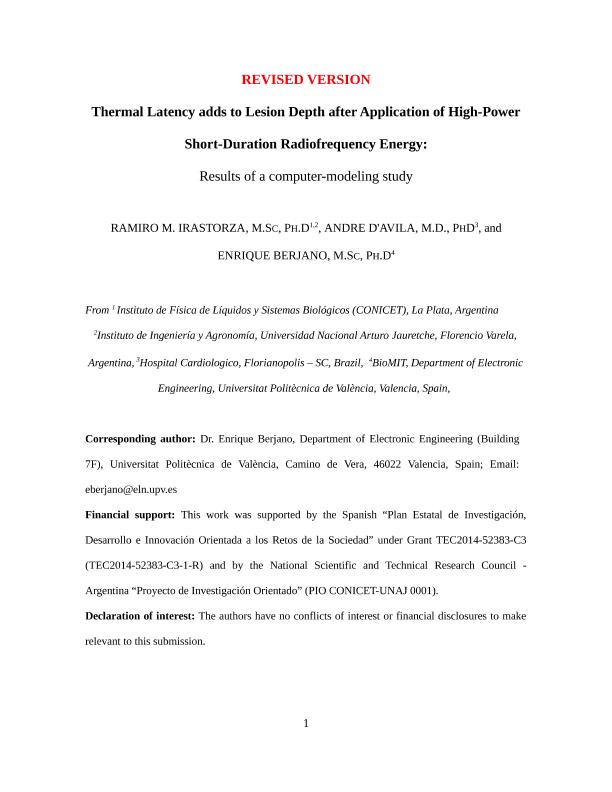Artículo
Thermal latency adds to lesion depth after application of high-power short-duration radiofrequency energy: Results of a computer-modeling study
Fecha de publicación:
02/2018
Editorial:
Wiley Blackwell Publishing, Inc
Revista:
Journal Of Cardiovascular Electrophysiology.
ISSN:
1045-3873
Idioma:
Inglés
Tipo de recurso:
Artículo publicado
Clasificación temática:
Resumen
Introduction: The use of ultra-short RF pulses could achieve greater lesion depth immediately after the application of the pulse due to thermal latency. Methods and results: A computer model of irrigated-catheter RF ablation was built to study the impact of thermal latency on the lesion depth. The results showed that the shorter the RF pulse duration (keeping energy constant), the greater the lesion depth during the cooling phase. For instance, after a 10-second pulse, lesion depth grew from 2.05 mm at the end of the pulse to 2.39 mm (17%), while after an ultra-short RF pulse of only 1 second the extra growth was 37% (from 2.22 to 3.05 mm). Importantly, short applications resulted in deeper lesions than long applications (3.05 mm vs. 2.39 mm, for 1- and 10-second pulse, respectively). While shortening the pulse duration produced deeper lesions, the associated increase in applied voltage caused overheating in the tissue: temperatures around 100 °C were reached at a depth of 1 mm in the case of 1- and 5-second pulses. However, since the lesion depth increased during the cooling period, lower values of applied voltage could be applied in short durations in order to obtain lesion depths similar to those in longer durations while avoiding overheating. Conclusion: The thermal latency phenomenon seems to be the cause of significantly greater lesion depth after short-duration high-power RF pulses. Balancing the applied total energy when the voltage and duration are changed is not the optimal strategy since short pulses can also cause overheating.
Palabras clave:
CARDIAC ABLATION
,
COMPUTER MODEL
,
RF ABLATION
,
THERMAL LATENCY
Archivos asociados
Licencia
Identificadores
Colecciones
Articulos(IFLYSIB)
Articulos de INST.FISICA DE LIQUIDOS Y SIST.BIOLOGICOS (I)
Articulos de INST.FISICA DE LIQUIDOS Y SIST.BIOLOGICOS (I)
Citación
Irastorza, Ramiro Miguel; d'Avila, Andre; Berjano, Enrique; Thermal latency adds to lesion depth after application of high-power short-duration radiofrequency energy: Results of a computer-modeling study; Wiley Blackwell Publishing, Inc; Journal Of Cardiovascular Electrophysiology.; 29; 2; 2-2018; 322-327
Compartir
Altmétricas




